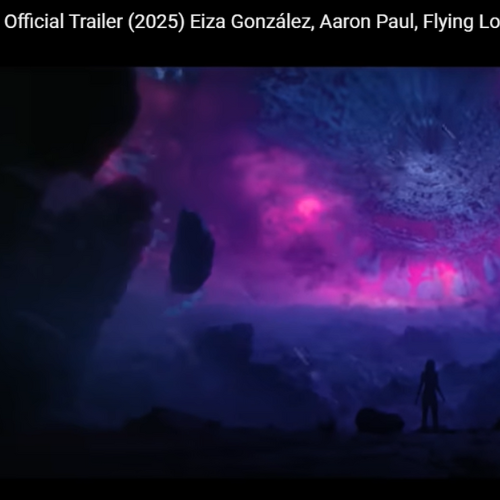A Nightmarish Descent Into the Unknown
Riya wakes on the cold floor of a dimly lit space station. Flickering lights, a droning emergency message, and bloodstained walls set the tone. An automated voice warns of “abnormal activity.” She stumbles upon the corpse of a crewmate, a knife buried in its chest. Outside, an alien terrain stretches beneath a purple-blue sky, with ash drifting like snow and shadows that mirror her movements.
This is the unnerving entry point into Ash — a sci-fi horror film directed by Flying Lotus and written by Jonni Remmler. Starring Eiza González as Riya and Aaron Paul as Brion, the film spirals through memory, madness, and trust, wrapped in an atmosphere of deep-space dread.
Unreliable Memory, Unthinkable Reality
“Who are we when everything we knew about ourselves is gone?”
Riya is left to piece together her identity through cryptic flashbacks and sensory chaos. Her crewmates have been brutally slaughtered, and she has no recollection of how or why. When Brion suddenly appears, claiming to be from an orbiting vessel answering her SOS, Riya must confront a chilling question — can she trust him, or is he connected to the bloodshed?
The film weaves in:
- Amnesia-driven paranoia
- Uncertain alliances
- Visions of gore and distorted memories
Riya’s mind becomes the real battleground, where the line between past trauma and present danger is hopelessly blurred.
Visual Terror Meets Sonic Madness
“Ash is a symphony of color, blood, and creeping madness.”
Flying Lotus crafts a hallucinogenic atmosphere using a vivid palette of reds, blues, and purples, backed by a relentless electronic score. The cinematography plunges viewers into scenes of:
- Claustrophobic corridors
- Cracked alien terrain
- Strobing lights and glitchy perspectives
While some CGI effects feel limited, the prosthetic makeup shines. Cracked alien skin, torn visors, and melting faces ground the horror in grotesque realism. Combined with muffled voices and breathing-heavy soundscapes, the film keeps viewers on edge, even in moments of stillness.
Psychological Horror That Cuts Deep
Themes of identity, survival, and instinct dominate the narrative. As Riya’s journey unfolds, the film asks:
If memory defines who we are, what happens when it’s gone?
Moments of calm quickly disintegrate into frenzied hallucinations or sudden outbursts of violence. The planet Ash becomes a metaphor — for inner rot, decaying sanity, and the loss of control.
Key ideas explored include:
- The fragility of self when stripped of memory
- Instinctual behavior vs. conscious morality
- The fear of becoming something inhuman
Each flashback forces Riya to question her role — was she a victim, or the one responsible for the carnage?
A Heroine on the Edge
Eiza González delivers a career-defining performance. Her portrayal of Riya captures every shade of emotion: terror, defiance, sorrow, and violent confusion. From high-stakes brawls to quiet, haunted moments, González makes Riya a gritty and magnetic lead.
Aaron Paul’s Brion, while visually compelling, often lacks emotional depth. Some viewers interpret this as intentional — suggesting Brion might not be real at all, but a projection of Riya’s fractured mind. His disheveled look and punk aesthetic hint at menace, but the emotional connection with Riya feels distant and ambiguous.
A Finale That Leaves You Spinning
The story builds toward a climax that’s both emotionally draining and visually explosive. With imagery reminiscent of The Thing and Alien, the final act plays with perception, trust, and what it means to confront truth.
“Ash doesn’t offer closure — it haunts you long after the credits roll.”
A mid-credits stinger drives the point home: there is no happy ending, only more questions. Some moments may confuse on first watch, but the film is designed to invite a second viewing, rewarding those who seek deeper meaning behind its madness. Ash is not just another space horror. It’s a bold, cerebral experience — blending existential dread, surreal beauty, and raw emotion into something unforgettable.
















